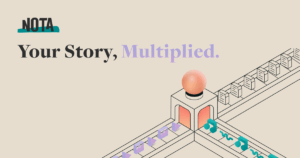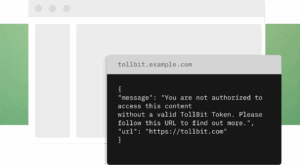Artificial intelligence is rapidly transforming the media landscape, offering exciting opportunities for newsrooms to enhance their operations, content creation, and audience engagement. Our view at LINA is this — strong, public interest journalism requires human reporting. But that doesn’t mean that AI tools, used responsibly, can’t help improve newsroom efficiency.
This starter kit provides a guide for newsrooms and journalists looking to understand, implement, and responsibly manage AI in their daily work.
AI Tools for Newsrooms
The AI landscape is fast-moving, with tools specifically designed to assist news publishers. Here are some handy AI tools that offer features for newsrooms, including SEO keyword support, image generation, audio editing, and more:
- Nota: This suite of AI-powered tools assists publishers in various aspects of content creation and distribution.
- Content Creation and Optimisation: Nota can automatically generate attention-grabbing headlines, condense long articles into concise summaries, identify relevant SEO keywords, and suggest improvements to content structure and readability.
- Distribution and Engagement: It helps create engaging social media posts with visuals, automates personalised newsletter creation, and provides data-driven insights into audience behaviour and content performance.
- Insight: By leveraging AI, Nota aims to streamline publishing workflows, enhance content quality, and boost audience engagement.
- Want a deeper dive into Nota? Explore our review of Nota here.
- Dall-E: An AI service capable of generating images from text descriptions, Dall-E is a powerful tool for publishers needing visual content.
- Image Generation: It can create images for articles, blog posts, and other content directly from text descriptions.
- Image Editing: Dall-E can edit existing images, allowing users to remove objects, change backgrounds, or add new elements.
- Image Variations: It can generate different versions of an image, offering various colour palettes or styles.
- Make: A powerful automation platform, Make connects various apps and services to create automated workflows, helping to streamline business processes, save time, and reduce errors.
- Key Features: It boasts a drag-and-drop interface for complex automations without coding, integrates with over 3,000 popular tools (like Google Workspace and Slack), and offers AI-powered automation for enhanced workflows.
- ElevenLabs: This suite provides audio-related AI tools, including realistic text-to-speech conversion and a useful speech-to-text transcribing service.
- Legitimate: Its primary offering is the Universal Bio widget, which pops up an author’s bio when an article is read.
- Insight: Legitimate is designed to increase readership trust and ensure that content creators receive due credit for their work.
AI Discounts available to LINA Members
LINA offers members access to numerous discounts for a number of newsroom tools and resources.
AI Policy Templates for LINA Members
Creating clear and responsible AI ethics policies is crucial for newsrooms, especially as they begin to integrate artificial intelligence into their journalism. Poynter, in collaboration with experts like Kelly McBride, Alex Mahadevan, and Tony Elkins, has developed a framework to assist newsrooms.
Core Templates for Your Newsroom:
Poynter’s AI Ethics Starter Kit (2025 Update)
This kit provides a customizable foundation for newsrooms to define how they will and will not use AI to serve their mission and uphold core journalistic values. It includes new information on AI in visual journalism and product creation, as well as a public-facing statement template.
LINA’s Newsroom AI Policy template
This document is intended as guidance and a template for creating an internal AI policy for your staff. Key considerations before you begin developing your policy include:
- Determining who is responsible for the use and final product after using generative AI tools.
- Deciding on processes and safeguards to ensure accuracy when using Generative AI.
- Clarifying when and where AI will be used (e.g., distinguishing between news stories and advertising campaigns).
- Setting guidelines for choosing which AI tools to use.
- Insight: It is crucial to evaluate tools for reliability (e.g., propensity to “hallucinate” or fabricate information), privacy risks (e.g., Open or Closed Source), their use of your data for training, and their value and risk to your business.
LINA’s “Generative AI in the newsroom: A Guide for Publishers”
- This document serves as a template for a public-facing policy, explaining your publication’s stance on AI to your audience. Key aspects covered include:
- Defining Generative AI for your audience.
- Transparency about AI use for individual pieces of work.
- Clarifying what AI will be used for (e.g., research, summarising, content creation, editing).
- The distinction between AI creating content (e.g., videos, text, subtitles, alt text) and editing content (e.g., tone suggestions, lighting corrections).
- Explaining why your newsroom uses AI, often citing limited resources and a commitment to accurate, unbiased reporting, while always ensuring human oversight.
- Examples of how AI is used for unpublished work (e.g., summarising data, transcribing interviews, brainstorming, hiring processes) and published works (e.g., making content accessible, grammatical guidance, creating multimedia, organising data).
- Crucially, this guide also states how AI won’t be used, such as altering videos/photos/audio beyond basic editing, or creating visuals of actual locations/brands/persons without clear disclosure.
Pointers to Additional Resources
To support your newsroom in navigating the evolving landscape of AI, here are some key resources:
- Poynter’s AI Ethics Guidelines: Download the full 2025 AI Ethics Guidelines and a shorter, public-facing version directly from Poynter.
- LINA’s Resource Directory:
Make sure you check our Technology and Useful tools and resources pages, which can help with design, distribution, security, and more. - LINA’s Policy Templates: In addition to AI policies, LINA provides other valuable templates that can be used in conjunction with your AI policy development, such as:
- Risk Management Policy Template.
- Privacy Policy Template.
- Complaints Handling Policy Template.
- Poynter’s Ethics & Leadership Section: This section of Poynter’s website offers ethics training, articles, and advice on AI ethics and other topics. Their team of AI ethics experts, including Kelly McBride, Alex Mahadevan, and Tony Elkins, are leading voices in media ethics.
Audience AI Literacy: It’s recommended to develop an AI literacy page or article for your audience to help them understand the basics of generative AI, why newsrooms use it, and how to avoid AI-generated misinformation. This also builds a more robust vocabulary for describing AI.




